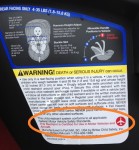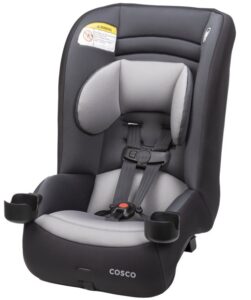2024 Recommended Car Seats for Airplane Travel

![]()
![]()
![]()
![]()
![]()
Best Lightweight Car Seats for Traveling
It’s the travel season once again, and for many families with small children that includes flying somewhere. Since so many carseats are heavy and bulky, it makes sense in some cases to invest in a lightweight carseat just for traveling. Plus, this spares you the hassle of re-installing your main carseat when you get back to your own car, weary from traveling.
Ideally, a spare travel carseat should be lightweight (under 15 lbs.), easy to install with the lap belt on an airplane seat and narrow enough to fit in a typical coach/economy seat.
With those criteria in mind, here are our favorite travel carseats:
Infant carseats – no need to buy anything new as long as your current infant seat can be installed without the base. While it may be possible to drag the base with you on your trip, that’s just making life harder than it needs to be. As long as your infant seat allows installation without the base (most do but there are some discontinued models that didn’t allow it), it’s easy to install the carrier rear-facing with the lap-only belt on the plane.


If you’re leaving the base at home – make sure you practice baseless installation a few times so when you arrive at your destination you know how to install the carseat properly in the car, using a typical lap/shoulder belt. We have a VIDEO that demonstrates my technique for quick and easy installations of an infant carseat without the base.
Please Note: Using a wrap, sling, front pack or any type of babywearing device is NOT a safe alternative for your baby or toddler because they aren’t engineered to restrain your child in any event that can be measured in g forces. Plus, you technically aren’t allowed to wear your child during take-offs or landings, when the risks are highest.
For rear-facing infants and toddlers:
If you plan to install a convertible seat rear-facing on the plane then you’ll be best served by something that is fairly compact. A more compact car seat will increase your chances of it actually fitting rear-facing in the space you have to work with.
 Cosco Scenera NEXT:
Cosco Scenera NEXT:
Rear-facing 5-40 lbs., or up to 40″ tall. Forward-facing 22-40 lbs., or up to 43″ tall
 Evenflo Tribute:
Evenflo Tribute:
Rear-facing 5-40 lbs., or up to 37″ tall. Forward-facing 22-40 lbs., or up to 40″ tall
 Graco Contender Slim
Graco Contender Slim
Rear-facing 5-40 lbs. Forward-facing 22-65 lbs., or up to 49″ tall.
No matter which seat you decide to take on the plane for your child – you will want to know where the FAA approval is located, in case one of the flight attendants asks to see proof that your carseat is certified for use in an aircraft.
Look for RED lettering on one of the sticker labels. The FAA language is required to be printed in red ink but the sticker label placement will vary from seat to seat. The language can vary slightly but in general, this is what you’re looking for:




For forward-facing kids:
Your best bet is a car seat that’s lightweight, fairly narrow, with tall top harness slots and a weight limit of 50 lbs. or more. Keep in mind that combination seats (aka harness/booster) can only be used on the plane if your child is using the 5-pt harness. Booster seats (or combination seats used without the harness in booster mode) are not FAA certified and cannot be used on an airplane because all booster seats require a lap/shoulder belt, which airplanes don’t have.
 Evenflo Maestro Sport:
Evenflo Maestro Sport:
Forward-facing only for kids at least 2 years old. With 5-point harness from 22-50 lbs., up to 50″ tall
 Evenflo Sonus 65:
Evenflo Sonus 65:
Rear-facing 5-40 lbs., or up to 40″ tall. Forward-facing for children at least 2 years old, 22-65 lbs., up to 50″ tall
 Graco Contender Slim:
Graco Contender Slim:
Rear-facing 5-40 lbs., Forward-facing for children at least 1-year-old, 22-65 lbs., or up to 49″ tall.
*Editor’s Note: Contender’s unique forward-facing beltpath is behind the plastic back of the shell. This unusual design creates a barrier so your forward-facing child won’t feel the bulky metal latchplate of the airplane seatbelt in their lower back.
 Safety 1st Jive:
Safety 1st Jive:
Rear-facing 5-40 lbs., or up to 40″ tall. Forward-facing for children at least 1-year-old, 22-65 lbs., up to 43″ tall. Ditch the optional cup holders for the flight because they just take up space.
 WayB Pico:
WayB Pico:
Niche folding travel seat. Expensive. Forward-facing only for kids at least 2 years old. 22-50 lbs., 30-45″ tall. We have a review of the WAYB Pico.
 CARES Harness*:
CARES Harness*:
A unique product for kids over 1-year-old who weigh between 22-44 lbs., and are under 40″ tall. *CARES harness is certified for use ONLY on the plane. It cannot be used in vehicles. It’s very useful for situations where you don’t need a carseat to use on the ground when you arrive at your destination. We have a review of the CARES Harness.
Once you have made the decision to fly with a car seat, there are many products available that can help you transport it through the airport.
Some are just generic luggage carts. Some products, like the inexpensive Car Seat Travel Strap, are made specifically for a carseat. There are also car seat travel bags with wheels but obviously, you can’t put your kid inside it too. Remember, the whole point is to use your car seat on the plane so you don’t need an expensive travel bag to protect your seat. You just need to find a convenient way to get it from your car to the plane and back.
Britax makes a folding travel cart accessory made specifically for Britax seats but there is no reason why it shouldn’t work for other brands of car seats too. The best thing about the Britax cart is that it’s sturdy enough to haul the car seat and a smaller kid for short distances!

Remember, only carseats with an internal harness can be used on a plane. You cannot use a booster seat on an airplane because booster seats require a lap/shoulder belt and airplanes only have lap belts. If your child rides in a booster seat and you are bringing it with you, you can gate check it or bring it on the plane and put it in the overhead bin (if it fits).

For more info on flying with kids and carseats – check out our related blogs on the subject:


Flying with a Car Seat? Know Your Rights!
Lap Babies on Airplane – A Warning All Parents Must See
Myth Busting: We’re All Going to Die in an Airplane Crash Anyway, So Why Use a Carseat?
Flying with Kids & Carseats – the checked carseat controversy
Travel Carseats: The Ultimate Guide to What You Want to Take on A Plane
An Open Letter to the FAA

 Cosco Scenera NEXT:
Cosco Scenera NEXT: Evenflo Tribute:
Evenflo Tribute: Graco Contender Slim
Graco Contender Slim Evenflo Maestro Sport:
Evenflo Maestro Sport: Evenflo Sonus 65:
Evenflo Sonus 65: Safety 1st Jive:
Safety 1st Jive: WayB Pico:
WayB Pico: CARES Harness*:
CARES Harness*:





